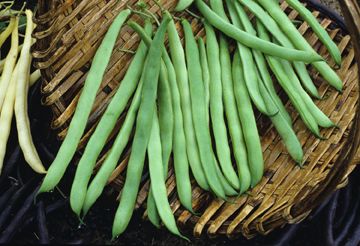How to Plant and Care for Bush Beans and Pole Beans
Looking for advice on how to plant and care for bush beans and pole beans? You’re in the right spot. The bean is a tender, warm season vegetable that ranks second only to the tomato in popularity. It’s a must-have for your garden. Read on to learn about proper care and harvesting techniques.

Bush Beans stand erect without support. They yield well and require the least amount of work. Green bush beans were formerly called "string beans" because fiber developed along the seams of the pods. Plant breeders have reduced these fibers through selection and green beans are now referred to as "snap beans."
Pole Beans climb supports and are easily harvested.
When to Plant
Beans are sensitive to cold temperatures and frost. They should be planted after all danger of frost is past in the spring (May 15th in Chicagoland). If the soil has warmed before the average last-frost date, an early planting may be made a week to 10 days before this date. You can assure yourself a continuous supply of snap beans by planting every 2 to 4 weeks until early August.
Spacing & Depth
Plant seeds of all varieties one inch deep. Plant seeds of bush beans 2 to 4 inches apart in rows at least 18 to 24 inches apart. Plant seeds of pole beans 4 to 6 inches apart in rows 30 to 36 inches apart; or in hills (four to six seeds per hill) 30 inches apart, with 30 inches between rows.
Care
Seeds of most varieties tend to crack and germinate poorly if the soil's moisture content is too high. For this reason, never soak bean seed before planting. Instead water just after planting or plant right before a heavy rain.
Beans have shallow roots and frequent shallow cultivation and hoeing are necessary to control small weeds and grasses. Because bean plants have fairly weak root systems, deep, close cultivation injures the plant roots, delays harvest and reduces yields.
Harvesting
Harvest when the pods are firm, crisp and fully elongated, but before the seeds within the pod have developed significantly. Pick beans after the dew is off the plants and they are thoroughly dry. Picking beans from wet plants can spread bean bacterial blight, a disease that seriously damages the plants. Be careful not to break the stems or branches, which are brittle on most bean varieties. The bean plant continues to form new flowers and produces more beans if pods are continually removed before the seeds mature.
Common Problems
The bean mosaic diseases cause plants to turn a yellowish green and produce few or no pods. The leaves on infected plants are a mottled yellow and are usually irregularly shaped. The only satisfactory control for these diseases is to use mosaic-resistant bean varieties.
Bright yellow or brown spots on the leaves or water-soaked spots on the pods are signs of bacterial bean blight. Bacterial blight is best controlled by planting disease-free seed; avoiding contact with wet bean plants; and removing all bean debris from the garden.
Fuzzy, bright yellow insects on my bean plants are larvae of the Mexican bean beetle. The adult resembles a large ladybug. The larvae do the most damage. They are generally not a serious problem, but they occasionally reach damaging numbers, particularly early in the season.
